Prices Fall In December 2022 As Investor Interest Wanes Amid A Weakening Economic Environment, With Land The Only Property Sector Seeing A Quarterly Price Gain.
CCRSI RELEASE – January 2023
(With data through December 2022)
Print Release (PDF)
Complete CCRSI data set accompanying this release
This month's CoStar Commercial Repeat Sale Indices (CCRSI) provides the market's first look at commercial real estate pricing trends through December 2022. Based on 1,495 sale pairs in December 2022 and more than 285,200 repeat sales since 1996, the CCRSI offers the broadest measure of commercial real estate repeat sales activity.
CCRSI National Results Highlights
-
U.S. COMPOSITE PRICE INDICES DIVERGED IN DECEMBER 2022 AS ANNUAL GAINS CONTINUED TO SLOW. The value-weighted U.S. Composite Index, which is more heavily influenced by high-value trades common in core markets, edged one point higher to 291 in December 2022, a gain of 0.2%, after falling for the prior four consecutive months, revised data show. The index was down by 1.6% in the 12-month period that ended in December 2022 but is 27.3% higher than in February 2020, before the onset of the COVID-19 pandemic.
-
Meanwhile, the equal-weighted U.S. composite index, which reflects the more numerous but lower-priced property sales typical of secondary and tertiary markets, fell three points to 310 in December 2022, a fall of 0.7% over the prior month, its second consecutive monthly loss, revised data show. The index gained 5.2% in the 12-month period that ended in December 2022 and is 30.7% above its February 2020 pre-pandemic level.
-
Both composite indices have been on a broad decelerating trend in year-over-year growth for the last six consecutive months as markets respond to an environment of higher interest rates as the Federal Reserve battles decades-high inflation.
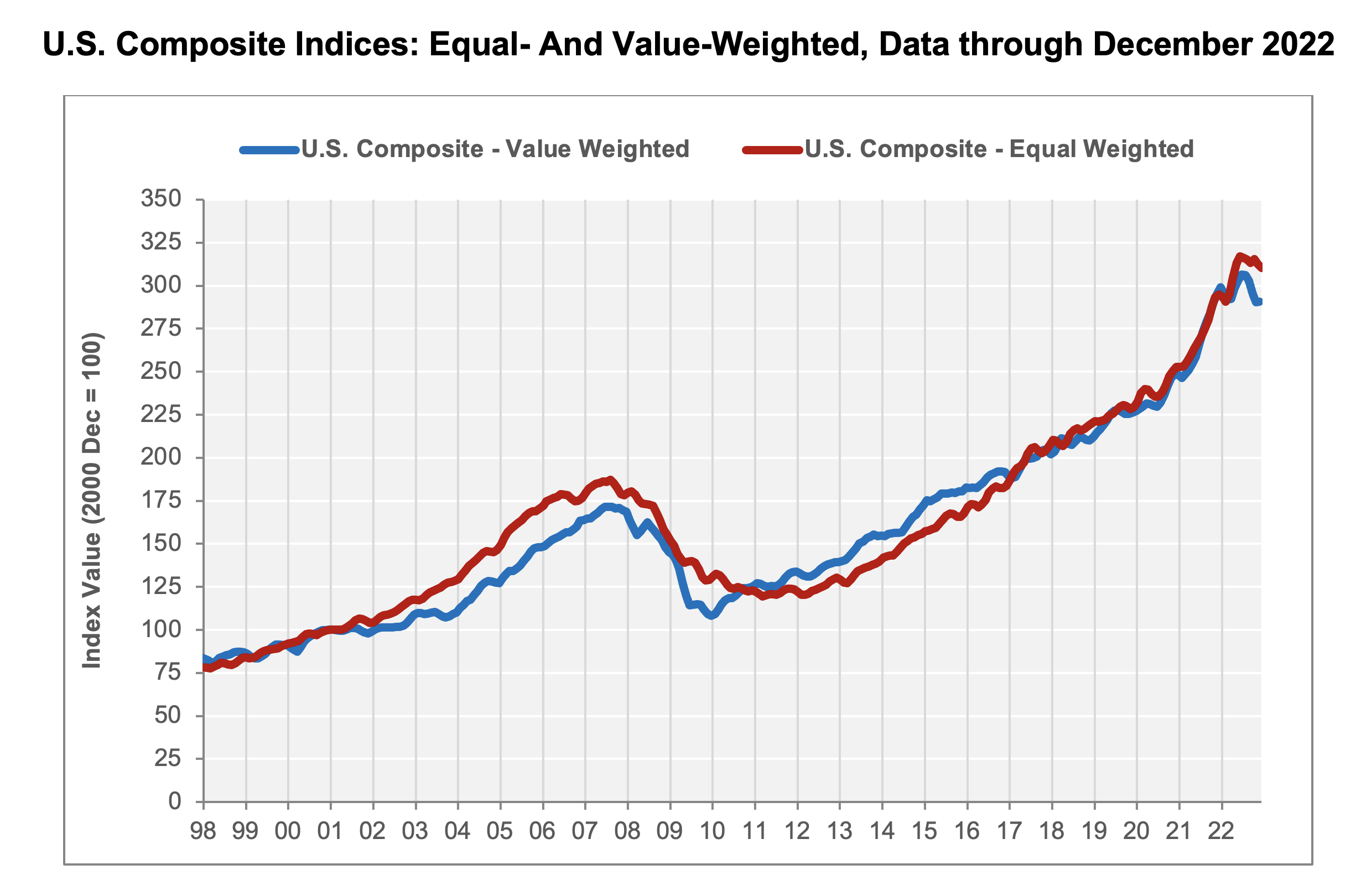

-
BOTH MARKET SEGMENTS OF THE EQUAL-WEIGHTED COMPOSITE PRICE INDEX FELL IN DECEMBER 2022, the second [consecutive?] month of declines.
-
The investment grade sub-index, more heavily influenced by higher-value assets, fell by 1.4% in December 2022, following a 1.7% decline in the prior month. The index saw growth of 1.6% over the 12-month period that ended in December 2022, its smallest 12-month gain since June 2020.
-
The general commercial sub-index, more heavily influenced by smaller, lower-priced assets, fell by 0.1% in December 2022, following a 0.7% decline in the prior month. This sub-index gained 6.8% over the 12-month period that ended in December 2022, its smallest 12-month gain since March 2021, revised data show.
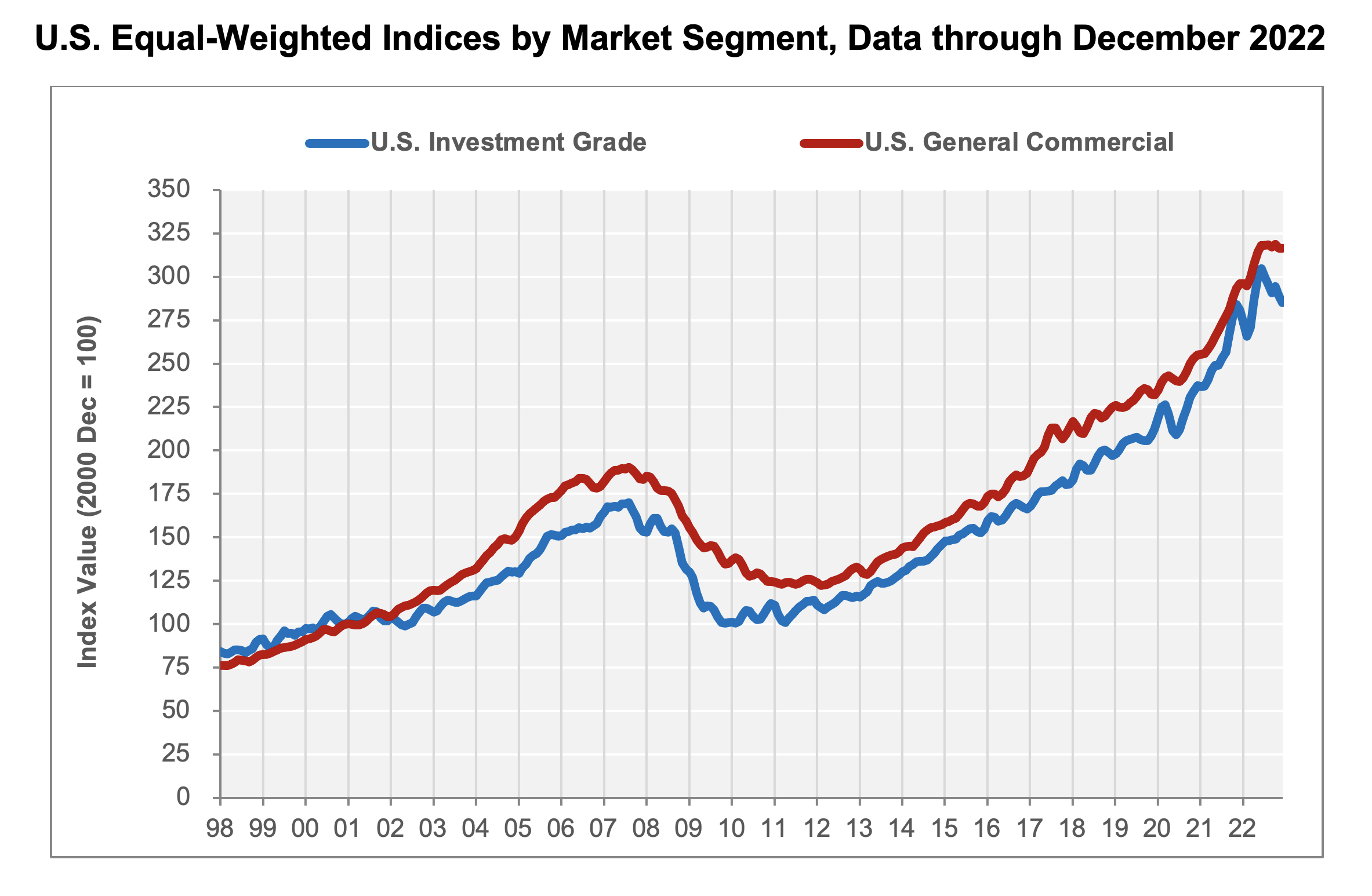
-
THE MULTIFAMILY SECTOR DROVE MOST OF THE PRICE GAINS IN THE VALUE-WEIGHTED INDEX OVER THE PAST DECADE. However, that sub-index has fallen in the past five consecutive months.
-
Although accounting for about 26% of the repeat trades recorded in December 2022, multifamily trades comprised 46.6% of the total monthly composite transaction volume.
-
The multifamily sector sub-index fell by 1.4% in December 2022, its fifth month of decline since reaching a peak of 421 in June and July 2022. The index saw price growth of 1% in the 12-month period that ended in December 2022, its slowest year-over-year gain since June 2010, when the index recorded an annual decline. Net absorption in multifamily units reached historic highs in 2021 in response to pandemic-era impacts on the housing market, motivating double-digit annual price gains and making the sector an attractive asset class. However, with both prices and mortgage rates elevated, eroding affordability has tempered absorption more recently.
-
The value-weighted composite index excluding the multifamily sector rose by 1.5% in December 2022 after edging lower in the prior two months in revised data. The index fell by 1.6% in the 12-month period that ended in December 2022, its third year-over-year decline. The index is 19.3% higher than its pre-pandemic level in February 2020, gaining about half the rate that the multifamily sector sub-index gained during that same period.
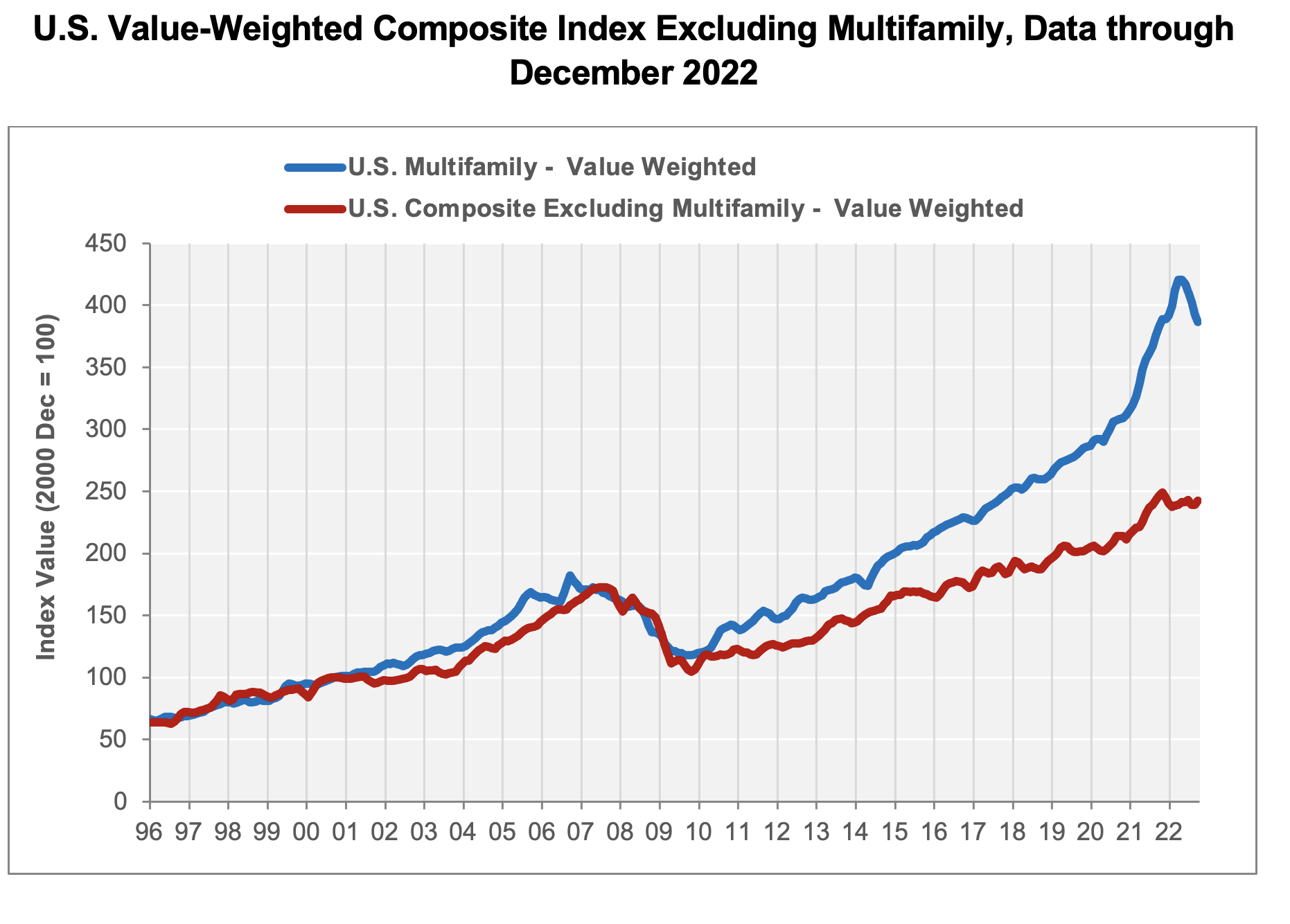
-
TRANSACTION VOLUME FELL FOR THE SIXTH CONSECUTIVE MONTH IN DECEMBER 2022, WITH SEGMENTS DIVERGING. Transaction activity fell to $11.2 billion in December, a 2.5% decline from the prior month’s upwardly revised volume and the lowest volume since March 2021. This was largely driven by the pull back in investment grade transaction volume which fell by 12.5% in December 2022 over the prior month to $6.6 billion. The general commercial segment volume, which accounted for about 42% of overall transaction activity in December 2022, staged a 16.6% gain over the prior month to $4.7 billion, revised data show.
-
Composite pair volume of $192.7 billion in the 12-month period ending in December 2022 was 8.5% lower than the 12-month period that ended in December 2021 due to unprecedented transaction activity in December 2021. The decline in annual volume was driven by the 12.5% fall in volume in the investment grade segment, which fell by 12.5% over the 12-month period that ended in December 2022 and accounted for about 64% of the overall annual transaction volume. The investment grade segment, which accounted for about 36% of the 12-month transaction volume, fell by 0.7% over the 12-month period that ended in December 2022.

-
THE SHARE OF REPEAT-SALE TRADES THAT WERE DISTRESSED REMAINS LOW. Only 33 of the 1,495 repeat-sales trades in December 2022, or about 2.2%, were distressed sales. In comparison, the monthly average share of distressed sales in the five-year period ending in February 2020, prior to the onset of the pandemic, was 3.6%. General commercial distressed sales accounted for 20 of the distressed trades in December 2022, or 1.3% of all repeat-sales trades, below its five-year pre-pandemic monthly average of 2.6%. Only 13 investment grade distressed sales were recorded in the month, accounting for 0.9% of all repeat sales trades, below its five-year pre-pandemic monthly average of 1.1%.
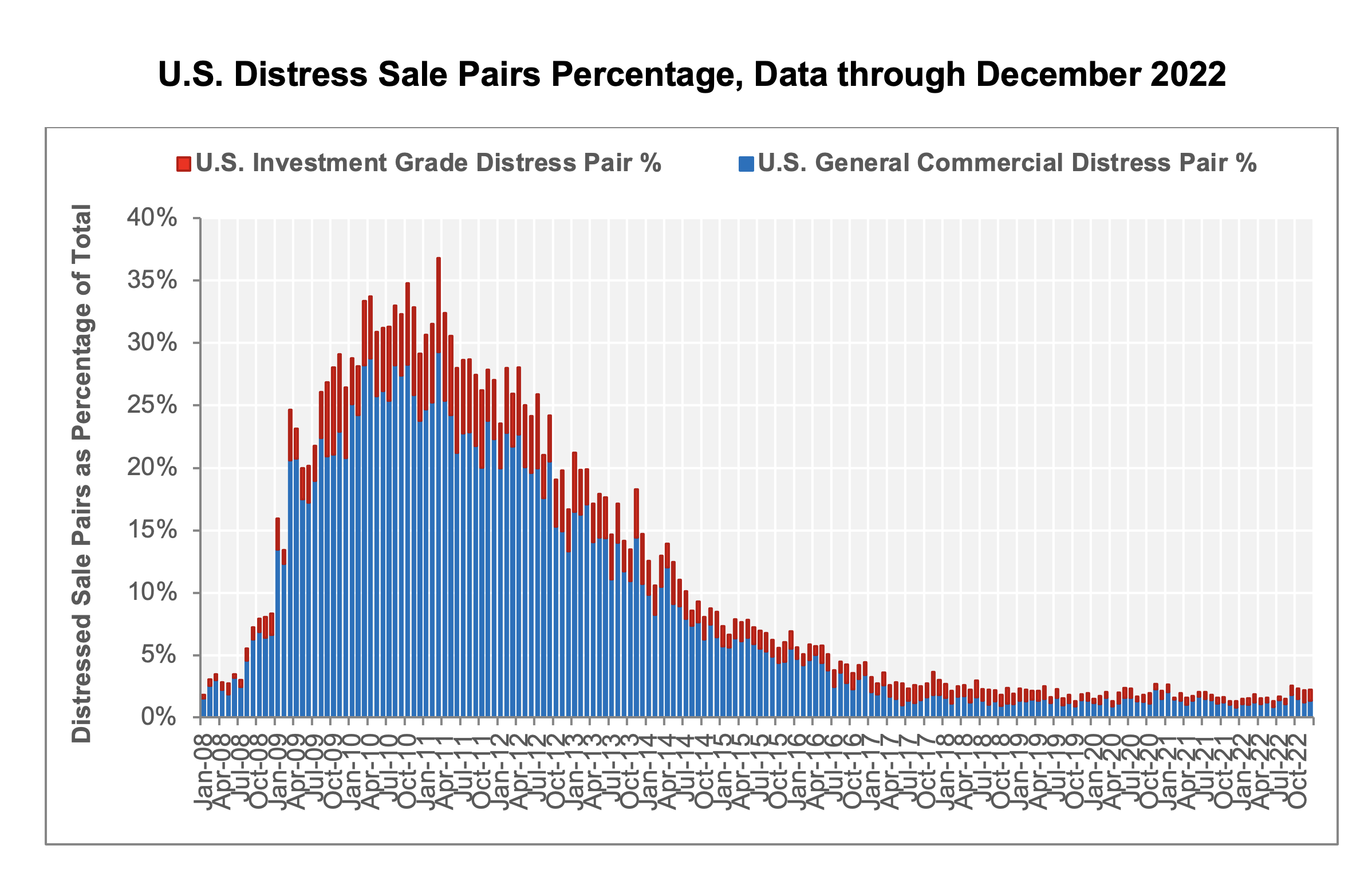
Quarterly CCRSI Property Type Results
-
PRICE GROWTH SLOWED ACROSS ALL PROPERTY TYPES AND WAS NEGATIVE ACROSS ALL WITH THE EXCEPTION OF LAND. The equal-weighted U.S. Multifamily Index fell by 2.1% in the fourth quarter of 2022, its second consecutive quarterly decline. The index grew 6.3% in the 12-month period that ended in December 2022, its slowest annual gain since June 2020.
-
THE U.S. INDUSTRIAL INDEX COOLED FOR THE FIRST TIME IN FIVE YEARS. The U.S. Industrial Index fell by 1.9% in the fourth quarter of 2022, its first decline since the fourth quarter of 2017. The index gained 15.6% in the 12-month period that ended in December 2022 and is 50.0% above its February 2020 pre-pandemic level, the strongest recovery among all property types. The Prime Industrial Metros Index fell by 2.1% in the fourth quarter of 2022 after an upwardly revised gain of 0.8% in the third quarter. The index is 7.3% higher than a year ago, the fastest annual gain among all prime market indices, and is 53.8% higher than its February 2020 pre-pandemic level, also the swiftest recovery.
-
HYBRID WORK ARRANGEMENTS CONTINUE TO WEIGH ON U.S. OFFICE PRICE GROWTH. The U.S. Office Index posted a 1.5% loss in the fourth quarter of 2022, its first quarterly decline since the fourth quarter of 2018. Over the 12-month period that ended in December 2022, office prices were up 3.5%, their slowest annual gain since June of 2019, and the slowest annual gain across all property segments. The index is now 23.3% higher than its pre-pandemic level. The Prime Office Metros Index fell by 2.4% in the fourth quarter of 2022, its second consecutive quarterly loss, and fell by 0.7% over the 12-month period that ended in December 2022, its first annual decline since June 2020, as fundamentals in core markets continue to struggle in this property segment.
-
CHALLENGES IN THE RETAIL SECTOR WEAKEN U.S. RETAIL PRICE GROWTH. The U.S. Retail Index slumped by 0.6% in the fourth quarter of 2022, its first quarterly decline since June 2020. The index gained 4.3% in the 12-month period that ended in December 2022, the slowest annual gain among all property type indices. The index was 25.5% higher in December 2022 than its pre-pandemic level. The Prime Retail Metros Index fell by 2.3% in the fourth quarter of 2022, and by 1.7% in the 12-month period that ended in December 2022, the largest annual decline across property segments.
-
THE U.S. HOSPITALITY INDEX FELL IN THE FOURTH QUARTER OF 2022, ITS SECOND QUARTERLY DECLINE. The U.S. Hospitality Index tumbled by 3.2% in the fourth quarter of 2022, the largest quarterly decline across property The index rose by 8.4% in the 12-month period that ended in December 2022, after facing the most challenging operating environment during the pandemic. The index is 18.1% above its February 2020 pre-pandemic level, the slowest recovery from the pandemic among all property types.
-
THE U.S. LAND PRICE INDEX ROSE FOR THE FIFTEENTH CONSECUTIVE QUARTER, REVISED DATA SHOW. The U.S. Land Index is the most volatile of the property type indices. The index gained 1.1% in the fourth quarter of 2022, the only property sector to show a price gain this quarter, and rose by 16.6% in the 12-month period that ended in December 2022, the fastest annual gain of all property-type indices. The index is 43.0% higher than its February 2020 pre-pandemic level.
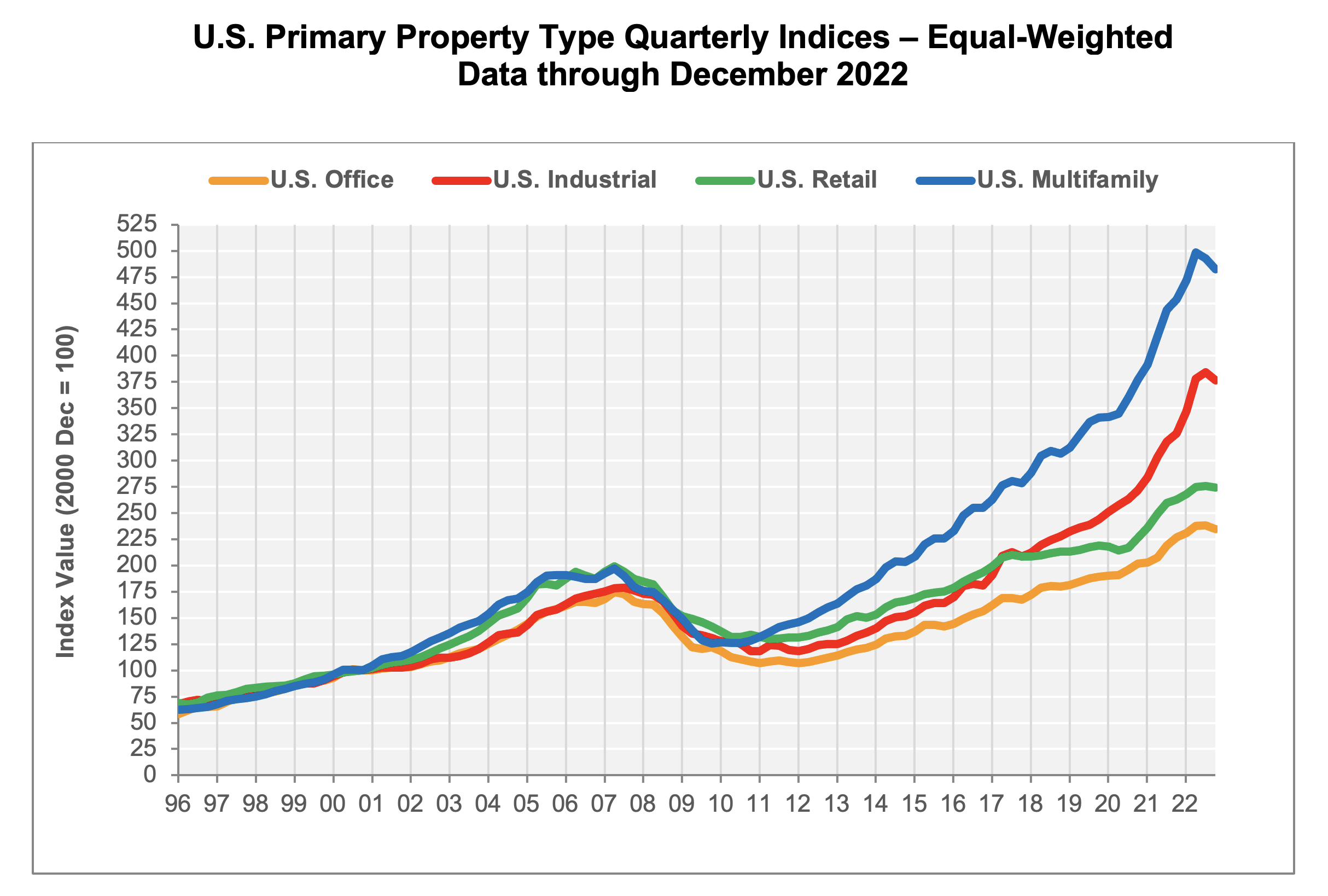
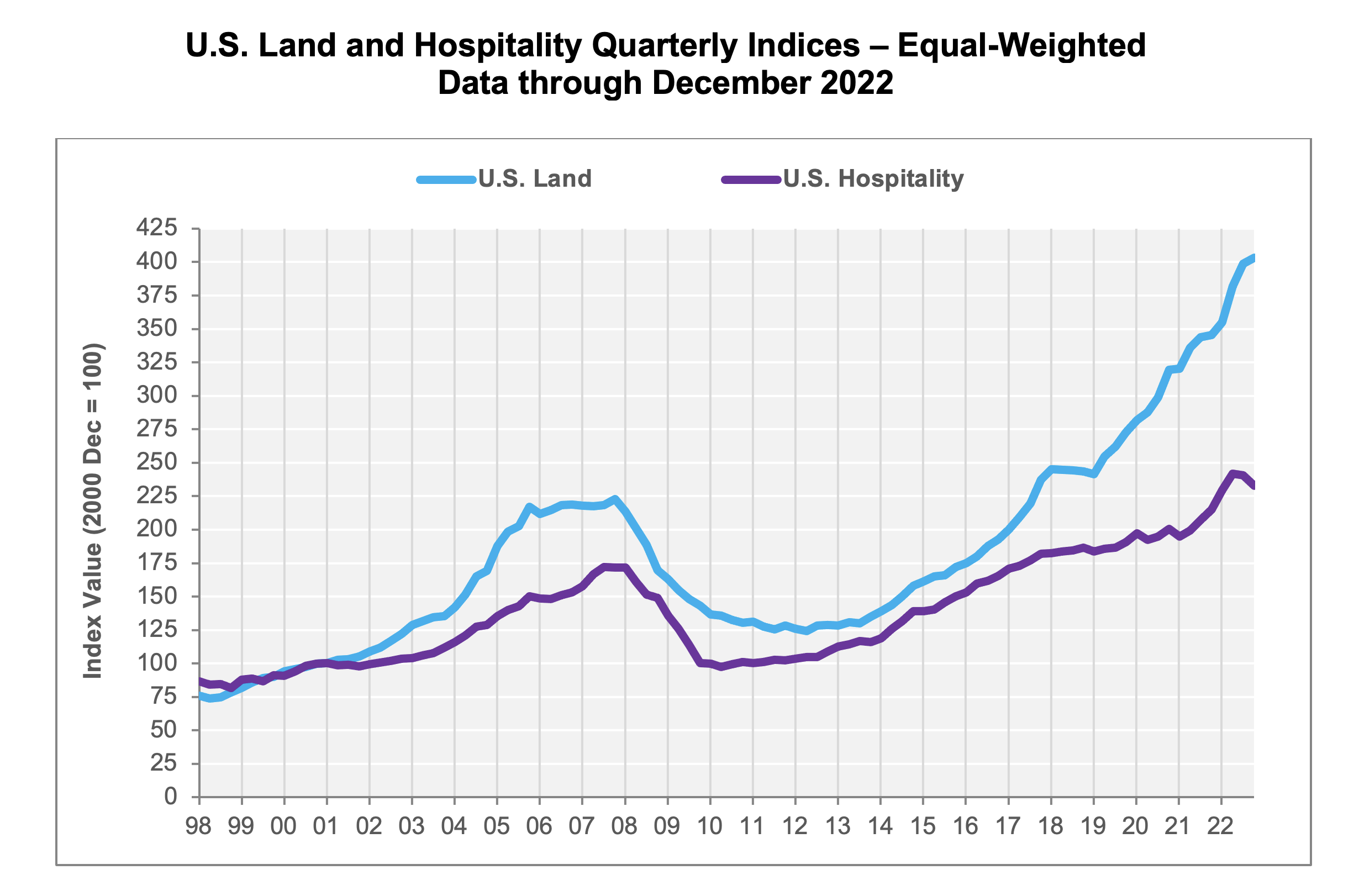
Quarterly CCRSI Regional Results
-
EQUAL-WEIGHTED PRICE GAINS TURNED NEGATIVE IN ALL REGIONS IN THE FOURTH QUARTER of 2022. The Northeast Composite Index fell by 0.4% in the fourth quarter of 2022, the smallest quarterly decline of all regions, after showing no price gains in the prior quarter, revised data shows. The South Composite Index fell by 2.1% in the fourth quarter of 2022, its first quarterly decline since the fourth quarter of 2017. The Midwest Composite Index fell by 0.6% in the fourth quarter of 2022, its second consecutive quarterly decline, while the West Composite Index fell by 2.3% during that period, the largest quarterly decline across all regions. All regions saw continued slowing price gains in the 12-month period that ended in December 2022 over the 12-month period that ended in December 2021.
-
ALL PROPERTY SECTORS IN THE MIDWEST REGION SAW PRICES FALL IN THE FOURTH QUARTER OF 2022. The largest decline in prices in the Midwest region occurred in the office property index, which fell by 2.4% in the fourth quarter of 2022, following a 0.7% decline in the prior quarter, revised data show. Both retail and industrial property indices in the Midwest fell by 2.1% in the further quarter, while the multifamily index fell by 0.6%. In the 12-month period that ended in December 2022, all Midwest property indices weakened following more robust annual gains in the prior quarter. The industrial segment saw the largest price gains over the 12 months that ended in December 2022, at 13.3%, followed by the multifamily segment (10.5%) and the office segment (0.9%). Price growth in the retail sector in the Midwest region fell by 1.9% over the same period, the only regional property sector in the Midwest region to experience an annual price decline.
-
PRICE GAINS IN THE FOURTH QUARTER OF 2022 SLOWED IN ALL PROPERTY SECTORS IN THE NORTHEAST REGION, TURNING NEGATIVE IN THE RETAIL AND MULTIFAMILY SEGMENTS. Growth in the industrial sector pushed prices 2.1% higher in the fourth quarter of 2022, the fastest price gains across property segments. The office sector saw a gain of 1.9% in the fourth quarter of 2022, the only region showing positive price growth in that property segment. The multifamily sector experienced a 1.9% fall in prices over the quarter and the retail sector in the Northeast saw a 2.3% decline in pricing. Over the 12-month period that ended in December 2022, the industrial sector saw the strongest price gains, at 17.9%, followed by office (10.6%), retail (5.7%) and multifamily (4.1%).
-
QUARTERLY PRICES IN THE WEST SLUMPED IN ALL PROPERTY SECTORS EXCEPT RETAIL. Pricing in the West multifamily segment fell by 2.3% in the fourth quarter of 2022, somewhat better than its 3.3% decline in the third quarter, revised data show. The industrial segment showed a 1.9% decline, it first pullback since the fourth quarter of 2019, while the office segment showed a similar decline of 1.9%, its second consecutive quarterly loss. Only the retail segment showed a quarterly price gain, of 1.0%. Over the 12-month period that ended in December 2022, the industrial segment saw prices rise by 11.8%, the fastest annual price appreciation of all property segments but a deceleration from the 16.9% annual gain in the prior quarter. Annual price increases slowed in all property segments, with multifamily property seeing the smallest annual gain, at 1.9%, followed but office (3.1%) and retail (5.2%).
-
THE SOUTH REGION SAW QUARTERLY PRICES FALL IN MOST PROPERTY SECTORS IN THE FOURTH QUARTER of 2022, WITH ONLY RETAIL SHOWING A GAIN. The retail sector in the South region eked out a 0.3% gain in the fourth quarter of 2022, the only sector to see price growth. This followed a decline in the prior quarter, revised data show. The largest fall in pricing in the South region was in the industrial sector, which lost 2.4%, the first decline seen since June 2020. The multifamily sector saw a 2.1% decline, its second consecutive quarterly pullback, while pricing in the office sector edged 0.1% lower in the fourth quarter of 2022. Over the 12-month period that ended in December 2022, all property segments saw decelerating annual gains over the prior quarter, with the sharpest slowdown seen in the office sector, where annual price gains slowed to 5.9% in the 12-month period that ended in December 2022, followed by the retail sector (6.6%) and multifamily (10.1%). The fastest annual price appreciation was seen in the industrial sector where pricing advanced by 19.6%, the fastest annual advance of all property types in the South and of all property types in all regions.
-
THE U.S. LAND PRICE INDEX ROSE FOR THE FIFTEENTH CONSECUTIVE QUARTER, REVISED DATA SHOW. The U.S. Land Index is the most volatile of the property type indices. The index gained 1.1% in the fourth quarter of 2022, the only property sector to show a price gain this quarter, and rose by 16.6% in the 12-month period that ended in December 2022, the fastest annual gain of all property-type indices. The index is 43.0% higher than its February 2020 pre-pandemic level.
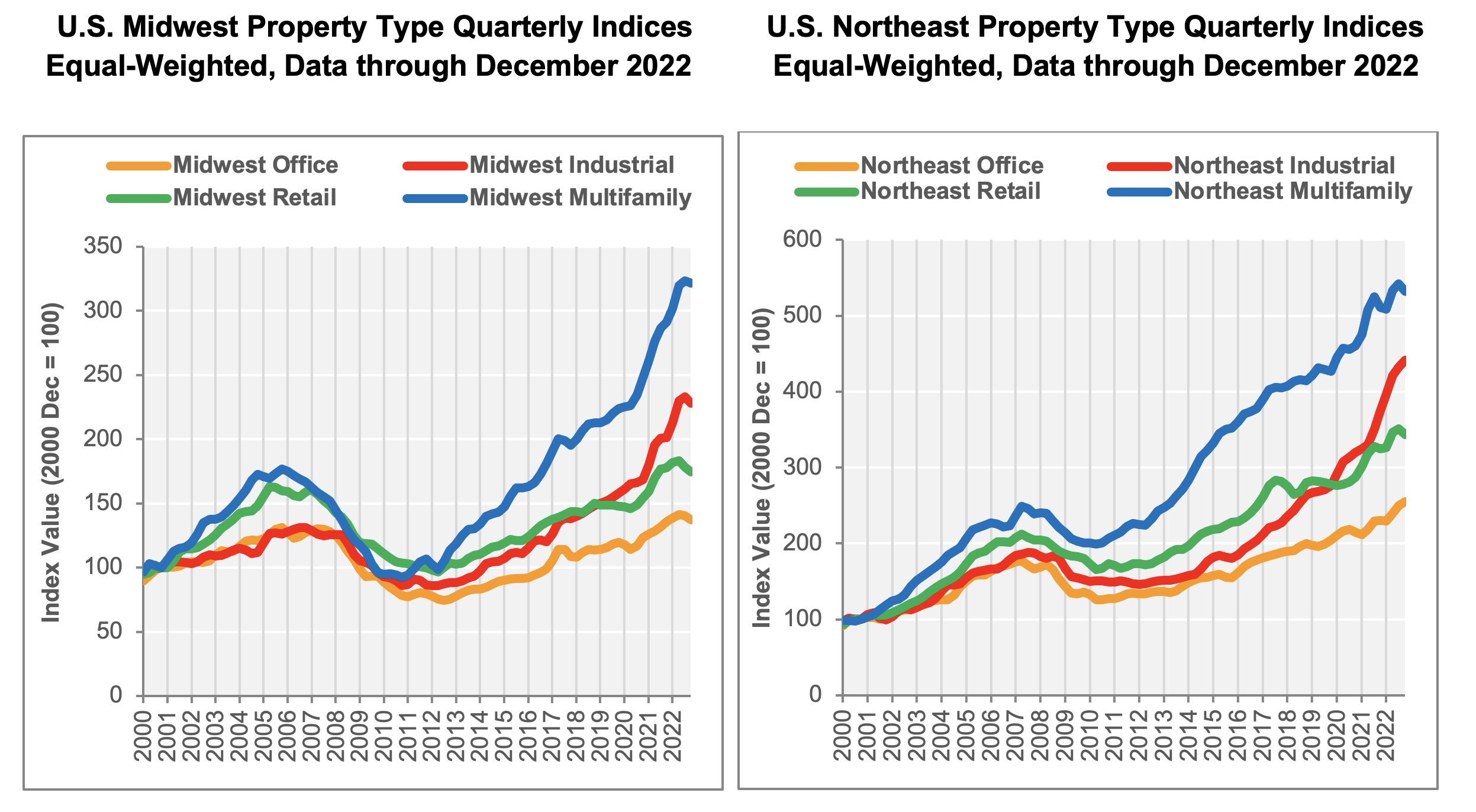
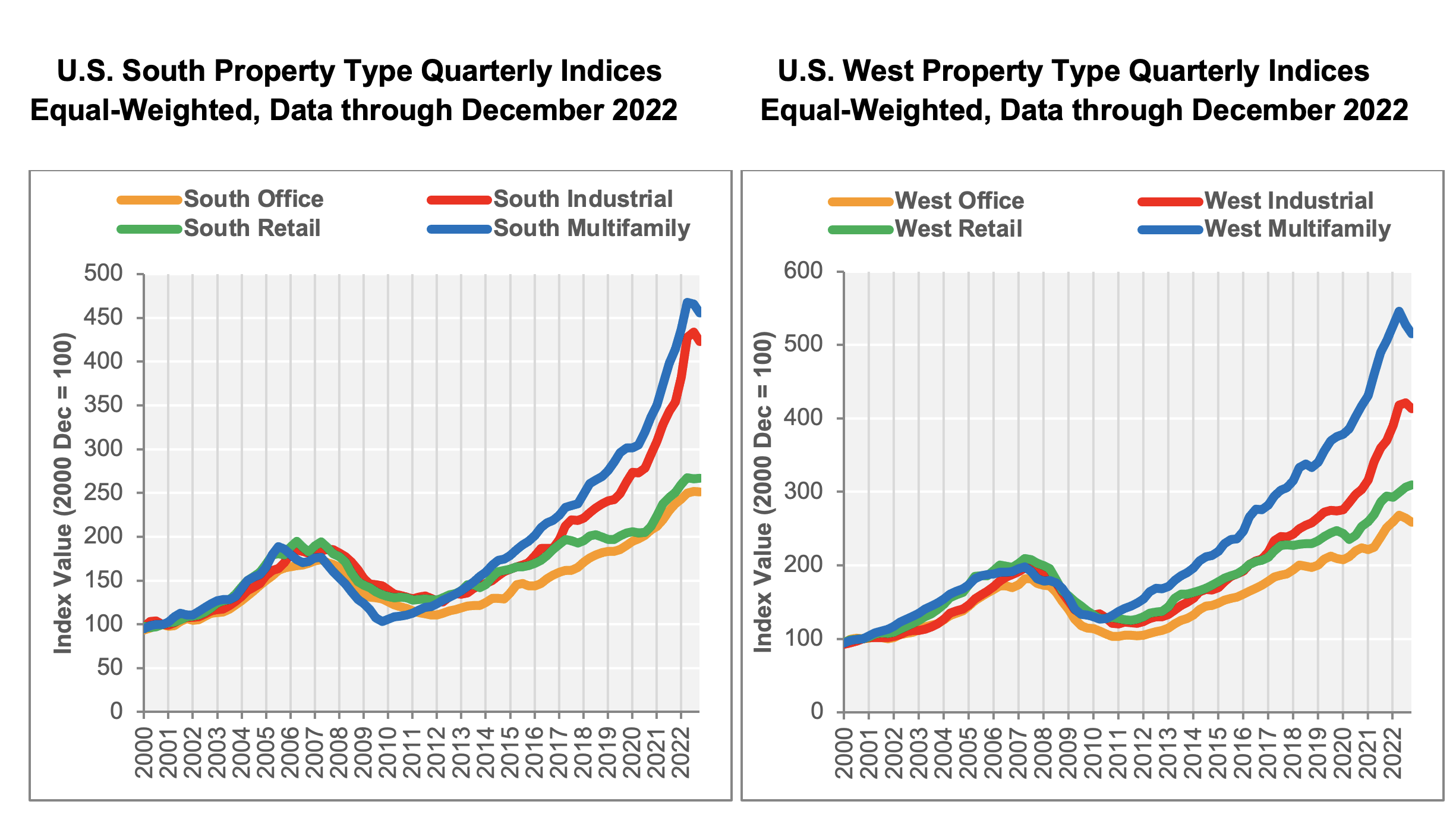
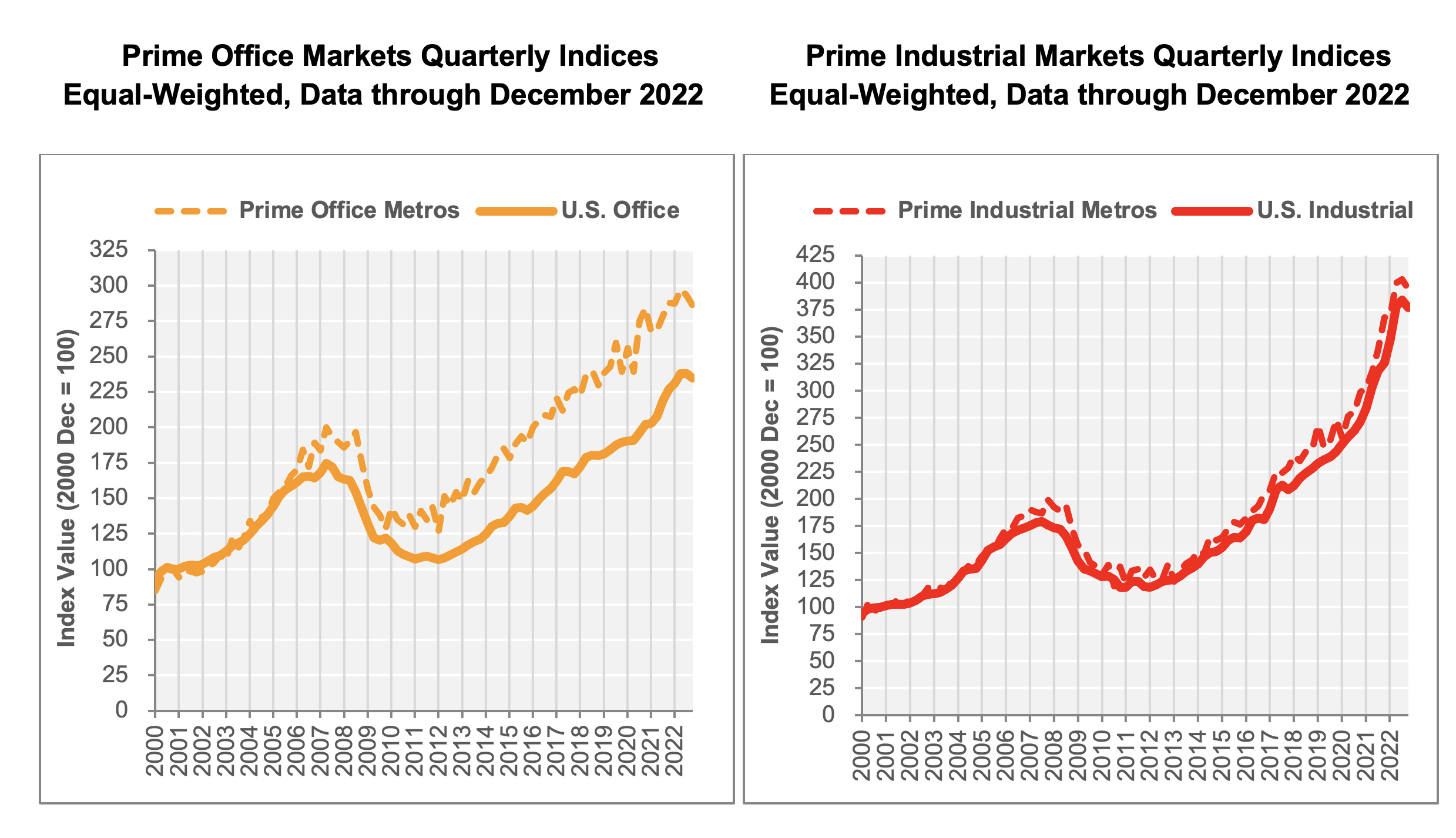
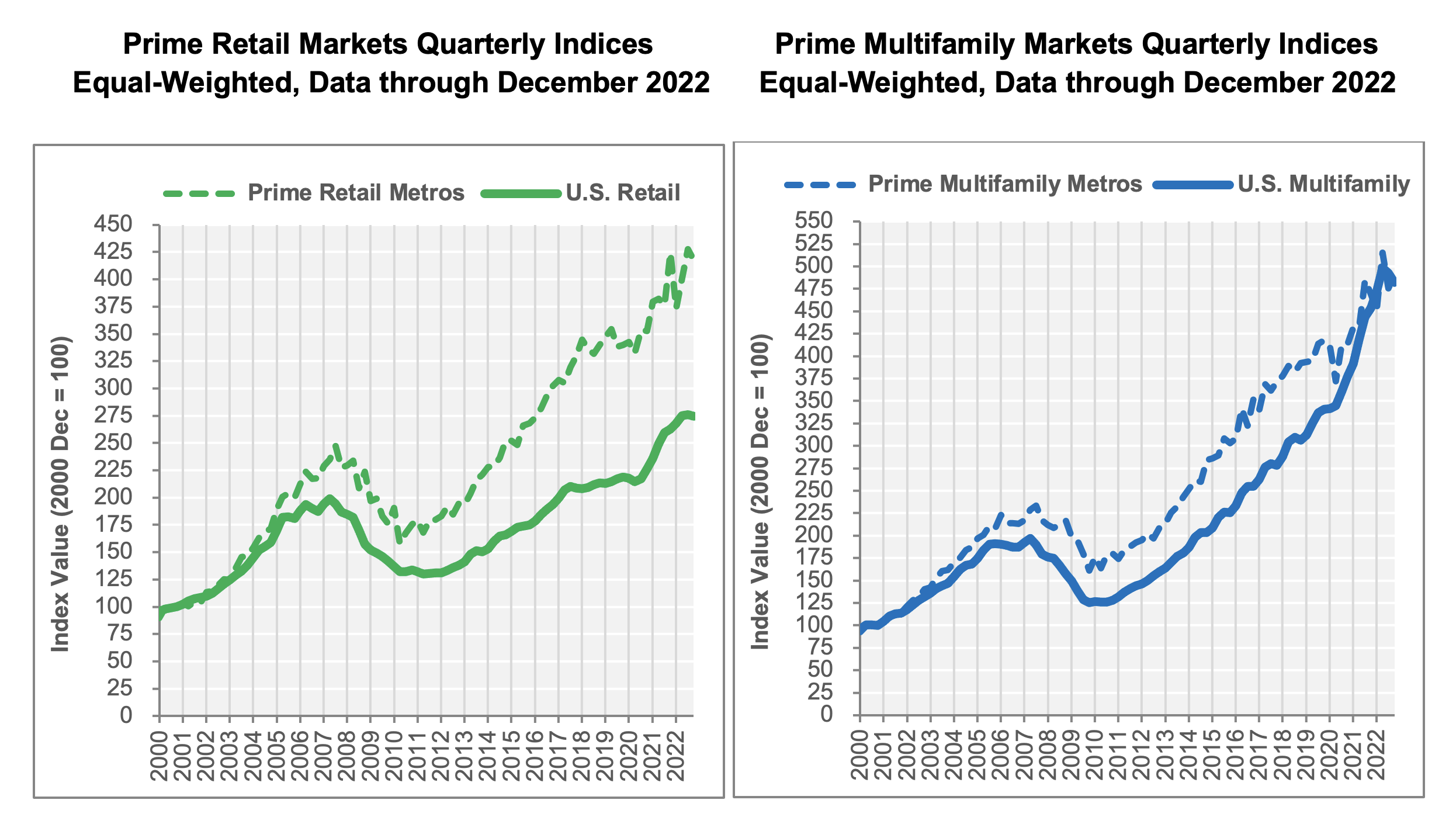
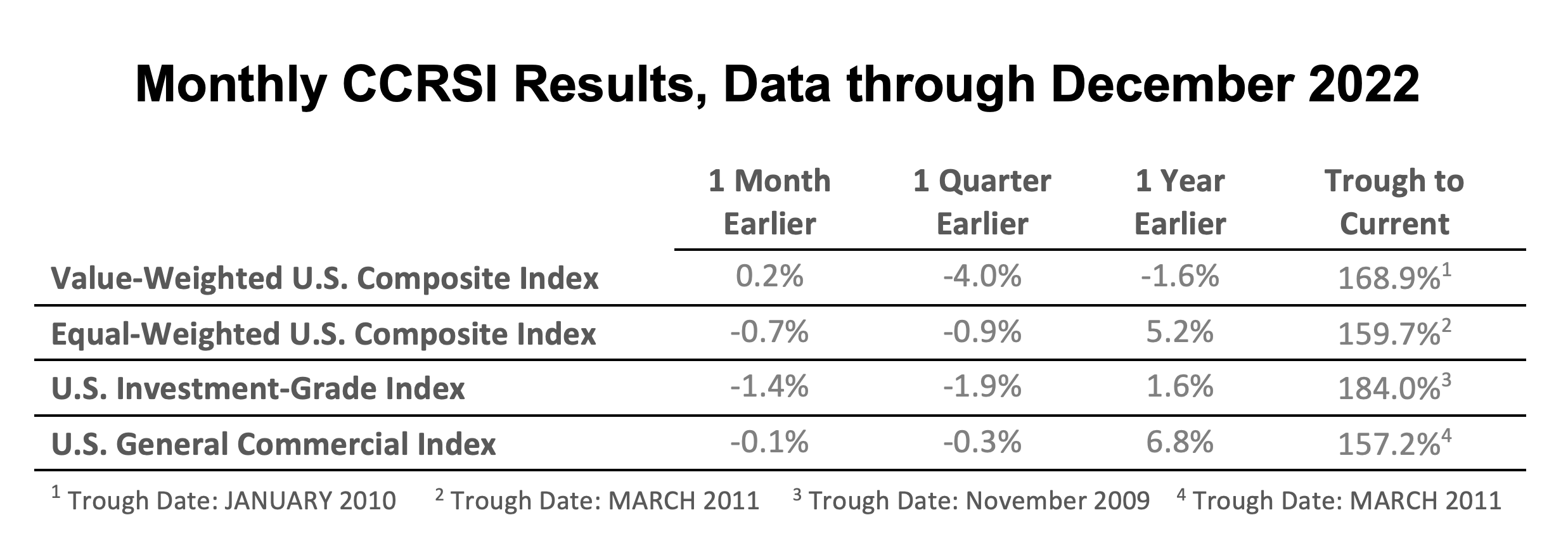
About The CoStar Commercial Repeat-Sale Indices
The CoStar Commercial Repeat-Sale Indices (CCRSI) are the most comprehensive and accurate measures of commercial real estate prices in the United States. In addition to the national Composite Index (presented in both equal-weighted and value-weighted versions), national Investment-Grade Index, and national General Commercial Index, which are reported monthly, 30 sub-indices in the CoStar index family are reported quarterly. The sub-indices include breakdowns by property sector (office, industrial, retail, multifamily, hospitality, and land), by region of the country (Northeast, South, Midwest, and West), by transaction size and quality (general commercial, investment-grade), and by market size (composite index of the prime market areas in the country).
The CoStar indices are constructed using a repeat sales methodology, widely considered the most accurate measure of price changes for real estate. This methodology measures the movement in the prices of commercial properties by collecting data on actual transaction prices. When a property is sold more than once, a sales pair is created. The prices from the first and second sales are then used to calculate price movement for the property. The aggregated price changes from all the sales pairs are used to create a price index. Historical price indices are revised as new data is recorded.
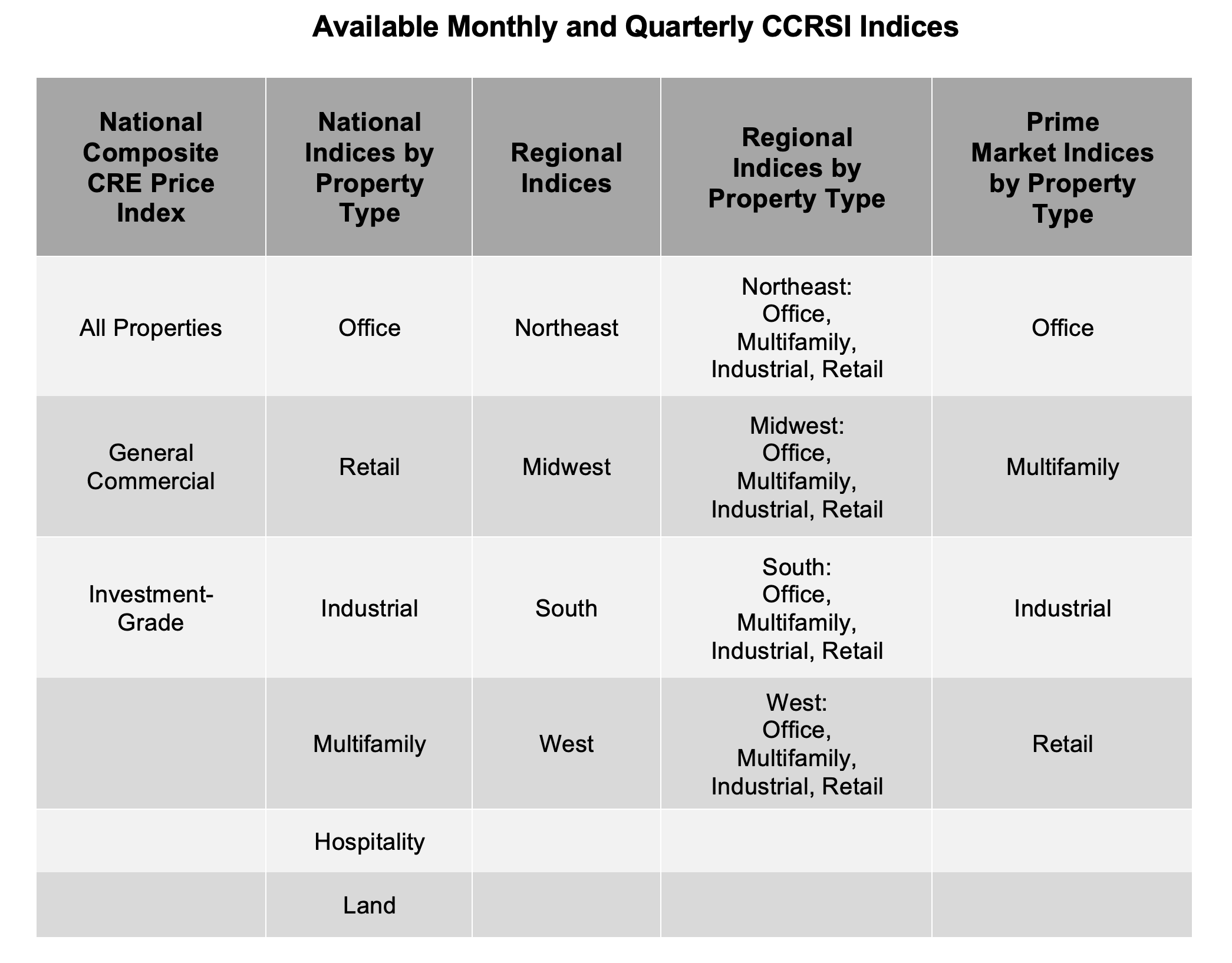
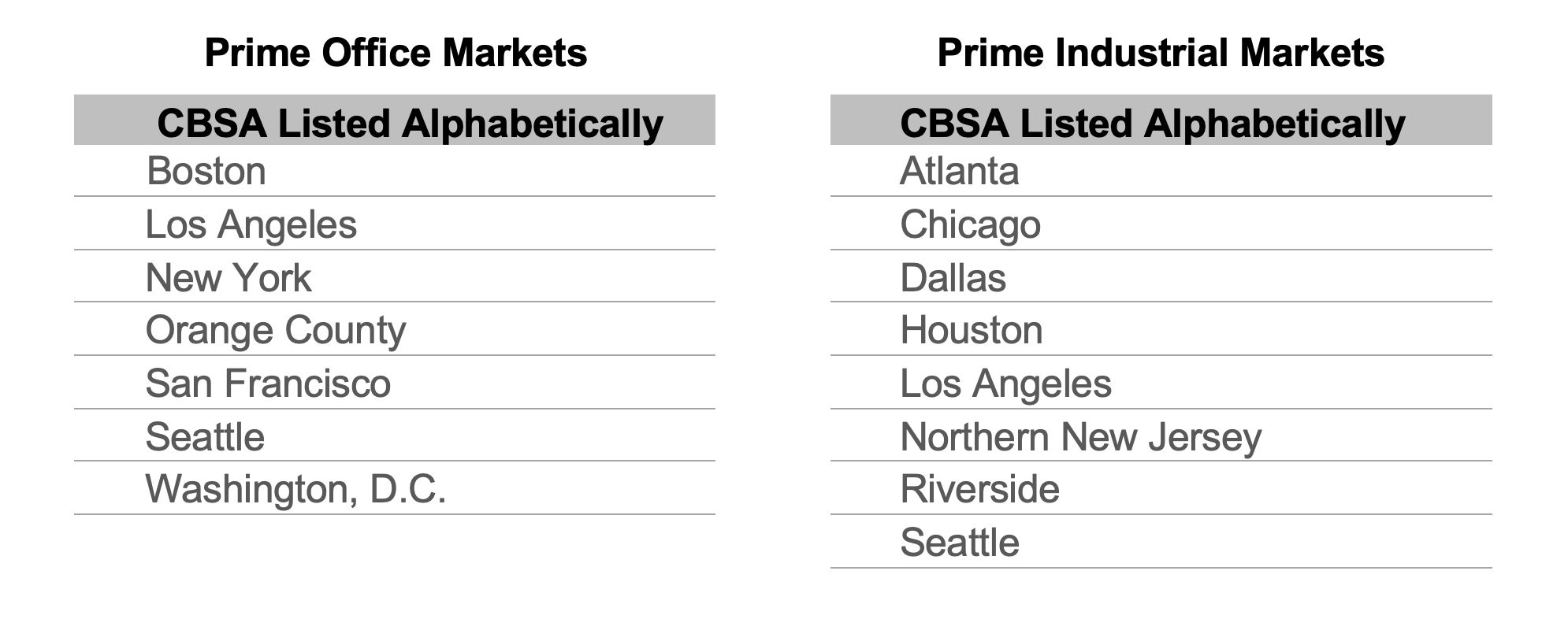
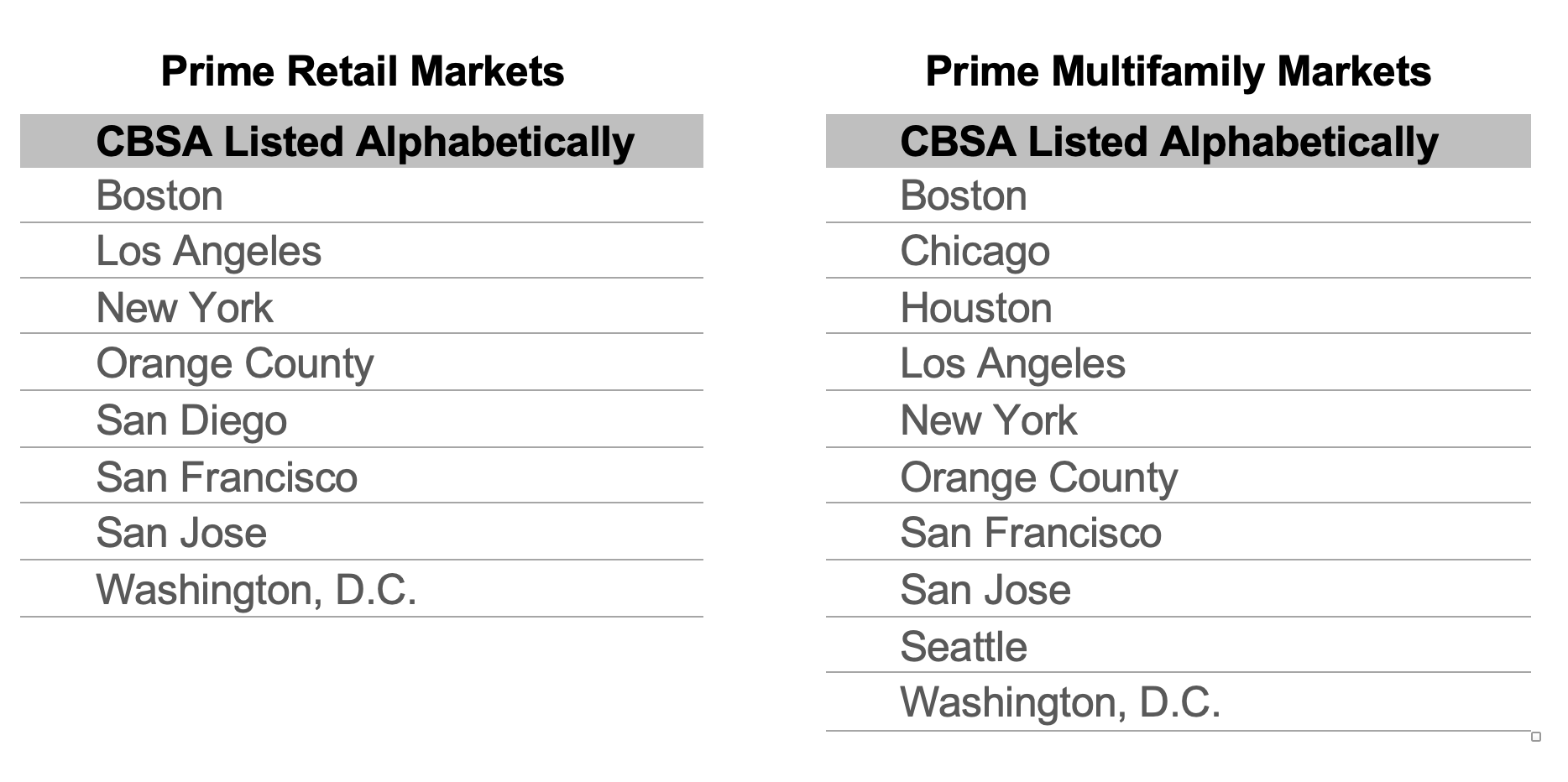
CONTACT:
Matthew Blocher, Vice President, Marketing & Communications, CoStar Group (mblocher@costar.com).
For more information about the CCRSI Indices, including the full accompanying data set and research methodology, legal notices, and disclaimer, please visit http://costargroup.com/costar-news/ccrsi.
ABOUT COSTAR GROUP, INC.
CoStar Group, Inc. (NASDAQ: CSGP) is a leading provider of online real estate marketplaces, information, and analytics. Founded in 1987, CoStar conducts expansive, ongoing research to produce and maintain the largest and most comprehensive database of commercial real estate information. Our suite of online services enables clients to analyze, interpret, and gain unmatched insight on commercial property values, market conditions and current availabilities. STR provides premium data benchmarking, analytics, and marketplace insights for the global hospitality industry. Ten-X provides a leading platform for conducting commercial real estate online auctions and negotiated bids. LoopNet is the most heavily trafficked commercial real estate marketplace online. Apartments.com, ApartmentFinder.com, ForRent.com, ApartmentHomeLiving.com, Westside Rentals, AFTER55.com, CorporateHousing.com, ForRentUniversity.com and Apartamentos.com form the premier online apartment resource for renters seeking great apartment homes and provide property managers and owners a proven platform for marketing their properties. Homesnap is an industry-leading online and mobile software platform that provides user-friendly applications to optimize residential real estate agent workflow and reinforce the agent-client relationship. Homes.com offers real estate professionals advertising and marketing services for residential properties. Realla is the UK’s most comprehensive commercial property digital marketplace. BureauxLocaux is one of the largest specialized property portals for buying and leasing commercial real estate in France. CoStar Group’s websites attract tens of millions of unique monthly visitors. Headquartered in Washington, DC, CoStar Group maintains offices throughout the U.S., Europe, Canada, and Asia. From time to time we plan to utilize our corporate website, www.costargroup.com, as a channel of distribution for material company information. For more information, visit www.CoStarGroup.com.

